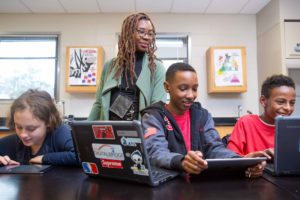
Overview
The Tools Competition aims to spur the development of new tools and technologies that address the urgent needs of learners. Because user engagement is a crucial component of creating successful tools, we aim to support ed tech developers as they begin or continue to engage families, teachers, and students.
This case study provides insight on how Springboard Collaborative engaged users in the development of their Parent Facing Literacy Screener (PFLS), and how the organization prioritizes user needs in their solutions overall. During this interview, Alejandro Gibes de Gac, CEO and Founder of Springboard Collaborative, shared tips from his team’s experience in working with parents and teachers.
Some strategies that Gibes de Gac highlights include:
- Encourage collaboration between parents and teachers by increasing accessibility of information
- Invite parents and teachers to create student goals that they can work towards together in their unique contexts
- Prioritize user engagement during product development, but also set processes in place, such as regular focus groups, that keep user engagement at the core of your organization
- Leverage existing systems such as school districts in order to reach users
- Take a deep dive into understanding the needs of users by creating user personas
Read on to find out how the team at Springboard Collaborative put these strategies into action.
What is the Parent Facing Learning Screener (PFLS)?
The Parent-Facing Literacy Screener, or PFLS, developed by Springboard Collaborative, is an assessment that parents can administer at home to understand their child’s reading development, set goals, and measure progress. The data from PFLS allows Springboard to personalize strategies that families and teachers can use to accelerate student learning.
Developing the PFLS to Fill a Gap
Research shows that in the US, nine out of ten parents think their child is performing at or above the appropriate grade level when, in reality, only one in four students are actually meeting the standard. The disconnect between the data accessible to schools and the information available to families makes it difficult for parents to effectively advocate for and support their children. This challenge, one that is particularly heightened for parents and children of marginalized communities, was the catalyst for the PFLS tool.
Although parents are eager to support their children, Springboard Collaborative found that almost all of the classroom-based assessments on the market required the expertise of an educator for administration, making them inaccessible for most families. The team saw promise in utilizing Natural Language Processing (NLP) to automate literacy assessment so that it would require neither classroom time nor teaching expertise to administer. Leveraging their existing programs that involved 60 district partnerships, the team at Springboard Collaborative captured thousands of recordings of children reading passages aloud. To train the NLP engine, Springboard collaborated with Worcester Polytechnic Institute (WPI). Using the recordings, the team at WPI trained the NLP engine to listen to the recordings and establish a high accuracy of assessment. By the conclusion of the project, the NLP engine had 93% accuracy, compared to the 92% accuracy of human assessors.
A Commitment to User Engagement
Because Springboard Collaborative was already an established platform when applying to the 2020 Tools Competition, the organization was able to leverage their existing district partnerships to reach users as they developed the PFLS. Gibes de Gac mentions that this – partnering with districts to leverage the people and resources that are already within school communities – is an approach that Springboard Collaborative has utilized since the beginning.
Springboard also has two formal advisory councils – a family and a teacher council – that each meet on a monthly basis. In between these touch points, the organization also regularly conducts individual conversations with parents and teachers to ensure that their solutions continue to best serve the intended audience. Internally, Springboard also has an impact strategy team that leads the learning and discovery work and a tech team that harvests all the data insights that are then translated into product features. In developing PFLS, the team conducted both focus group research and user research to gain insights.
Insights from Users
One critical insight that emerged from early usage of the tool was the realization that even when parents were more than willing to administer the PFLS at home and appreciated the insights it provided, they still also wanted the teacher’s perspective. Parents were eager to connect with teachers and hear about their child’s in-classroom behavior, learning, and what they could do to support at home. Similarly, parents had unique insights into their children that could be helpful for teachers at school. This helped Springboard realize the importance of fostering collaboration and connection between home and school, or more specifically between parents and teachers, through their solutions. Among other things, this understanding led to the development of a translation mechanism whereby assessments administered by teachers in the classroom are taken and translated into a meaningful and actionable format for parents.
Engaging with teachers regularly helped the team realize that they held a misguided assumption that most teachers, already spread so thin, only wanted a simple and fully automated tool. On the contrary, they found that teachers also wanted to feel connected to parents and wanted a tool that could be used in a broader context. Through conversations with parents and teachers, the team at Springboard Collaborative learned that while assessment was important, they were too narrowly focused on developing an assessment that made sense for the home context. Instead, they learned to take a more holistic approach because assessment “only comes to life within a broader context.” For PFLS, this broader context evolved to include goal-setting cycles – thinking about how the assessment creates greater visibility for parents, how greater visibility translates into growth goals, and how growth goals can lead to a learning plan and resources that help achieve the goal. Engaging with users and situating PFLS within this broader context allowed Springboard Collaborative to create a product that truly meets the needs of parents and teachers and ultimately improves student outcomes.
Advice for Ed Tech Developers
Gibes de Gac’s advice for organizations and individuals in the ed tech industry is to “hold tightly to the problem and lightly to the solution.” In other words, keep the focus on the problem you are trying to solve and treat the solution as a working hypothesis – as demonstrated by his team in the development of the PFLS.
He also stresses the importance of understanding your users and what they specifically need from your product or service, as this is what truly matters. He notes that you may need to go deeper than you think on user insights. For example, instead of simply reflecting on insights, use them to create user personas that help you bring to life, better understand, and satisfy users’ needs.
Finally, Alejandro encourages ed tech leaders to reorient their thinking around their organization’s work as a service to others rather than simply a product with features.



